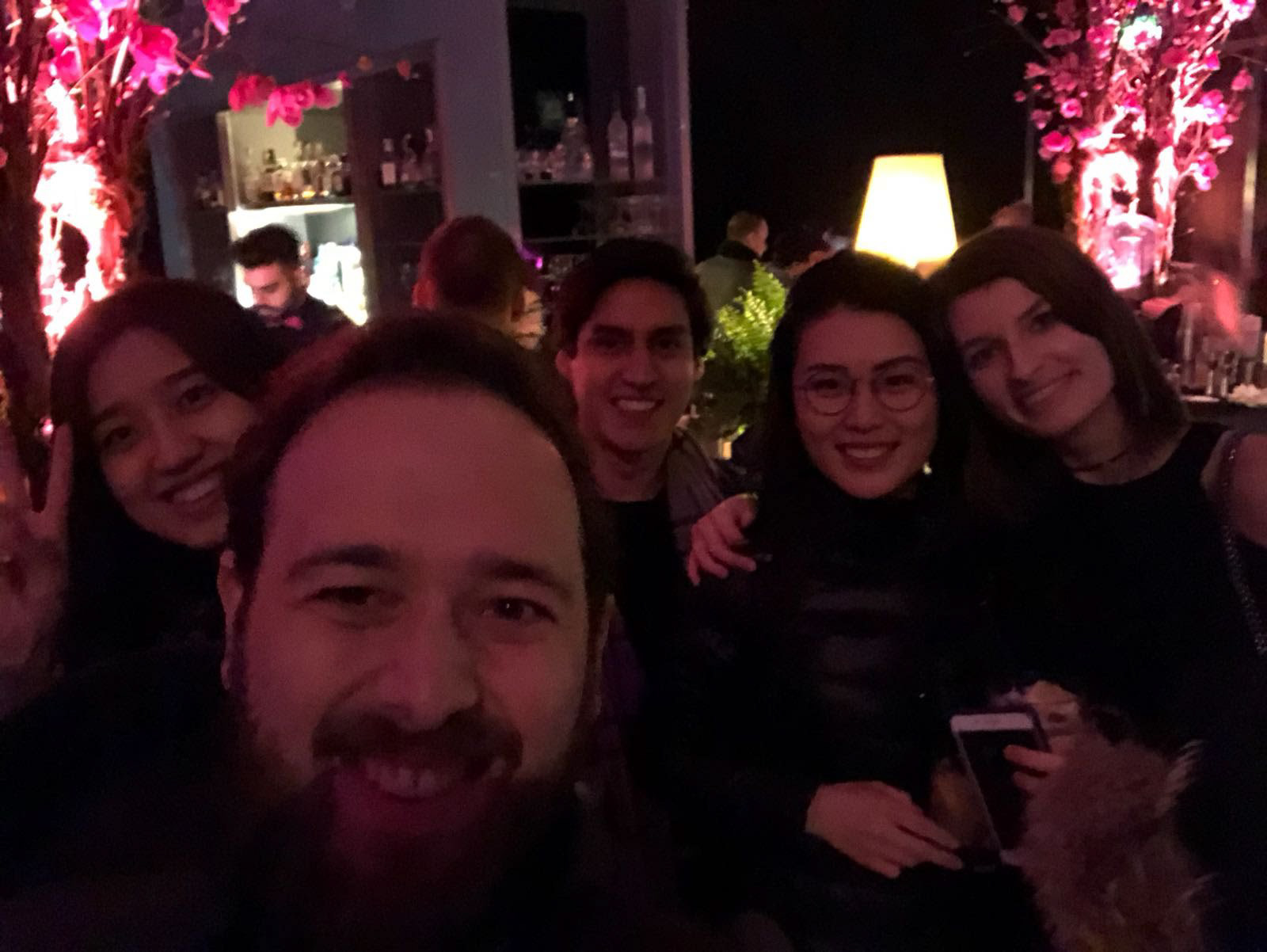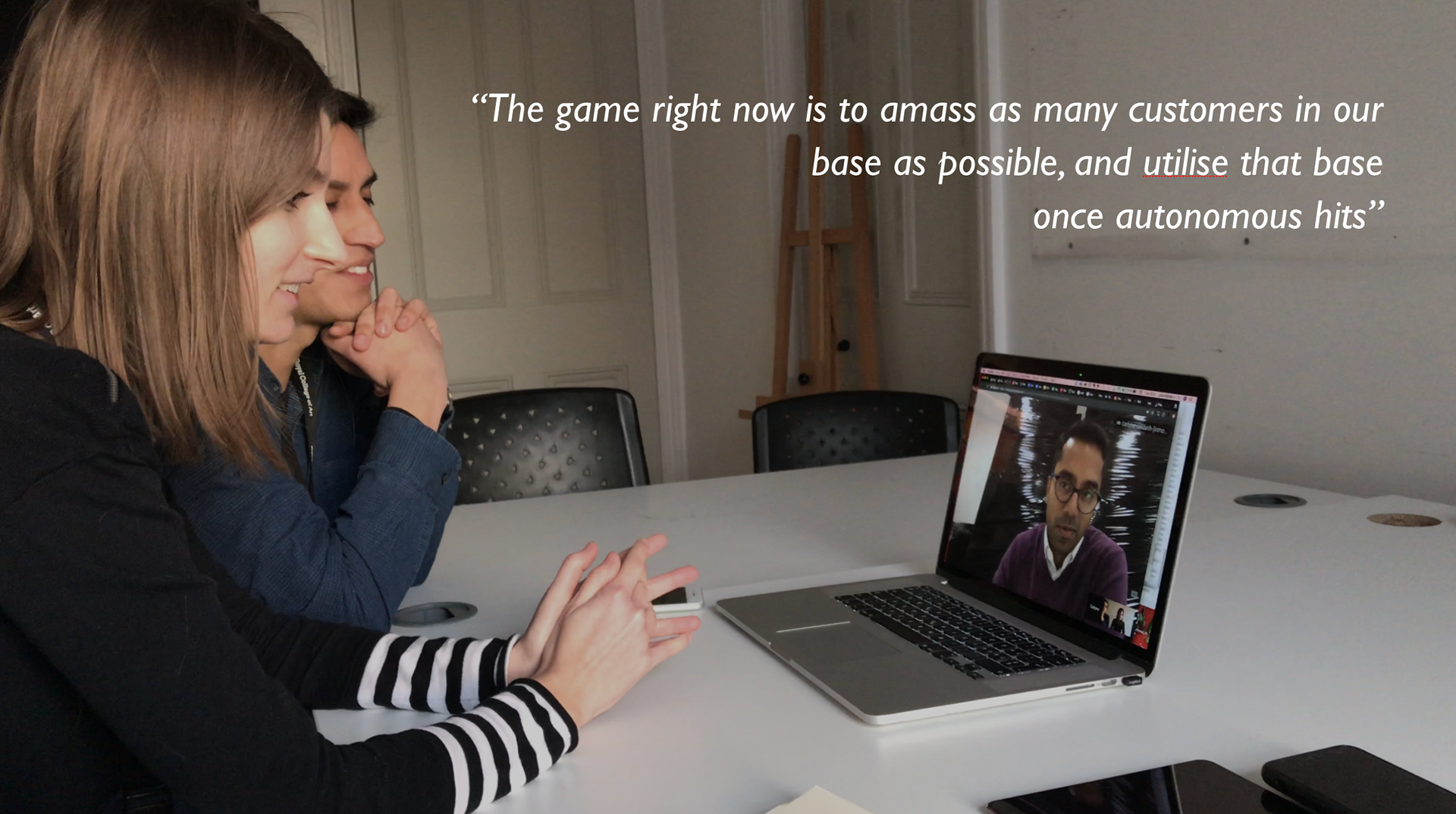YOURNEY
A social innovation project focused on examining the holistic experience of evolving corporate travel. Client: InMotion, Jaguar Land Rover's (JLR) venture-capital arm.
Year 1 // 8-Week Project
Team (5): Tim Worms, Xuelun Fu, Julia Rajnak, Shutong Guo, Jonathan Martell
Team (5): Tim Worms, Xuelun Fu, Julia Rajnak, Shutong Guo, Jonathan Martell


What is it?
Yourney is an intelligent business travel assistant covering all aspects of the business travel journey. This journey is not only about moving from A to B, but is part of a complex system of systems containing mobility, accommodation, expense management, and more.
But, how did we get there?
The Story
The Brief
We were given the following challenge: to develop an urban mobility solution that could be delivered as a premium service for the millennial demographic.
This prompted two basic questions for me: What exactly is premium? And, what is a millennial? We explored both throughout our research.
To help answer this question, our partner for this project was InMotion Ventures, an innovation wing of Jaguar Land Rover. Concentrated on investing and inventing businesses in the mobility, transportation and travel sector, they had already compiled a large, quantitative set of data concerning mobility usage. This helped narrow the project scope and highlight specific needs within the wide spectrum of mobility.
As my first foray into the social innovation side of service deign, I was excited to explore a mobility project for a second time, though this time with a commercial mindset.





Second term gave me a chance to get my hands dirty with more service design tools. With such a large group, I took the lead and framed a service vision early on to keep us unified, which allowed me to shift between tasks and problems rapidly to build out scenarios and prototype ideas for early testing with research subjects. My primary role was project manager of the group, but I was heavily involved in all aspects, including stakeholder maps, blueprints, and video production.
Research
Quickly after we began research, we realized that mobility was not limited to automobiles. Our talks with InMotion showed that they cared about more than just wheels, and they gave us room to think outside the box.
As our potential user base was significantly huge, we decided guerilla research would be a fast and low-cost way to gain sufficient insights to make informed decisions.
We found that for most of our potential users, mobility was viewed as an unavoidable aspect of modern life. It was a necessity that often added strain multiple times a day. It's one of the main components that truly affects the work-life balance. This proved to be a major concern for us, our partner, and potential users. Especially the fabled business millennial (high earning professional).


Reassurances
Premium
What set the business millennial apart from other millennials? They were a growing population of the workforce, often favoring flexibility over savings, and required a level of constant connection. As well, they still appreciated experiences over things, but they expected a level of personalization that would be defined as premium.
We asked experts in the airline, hotel, and banking industries to define a premium experience. Across the board, I began to realize they hit on a similar strategy: users needed reassurances throughout a journey. For example: if their train was late, they would expect an alert so they could make adjustments to their plans as needed. They were disgusted if they had to go out of their way to find the information or their plans were ruined by a lack of data.
Anything that interrupted their immersion in the experience risked devaluing the service in their eyes. This sharing of information, at the right time and before they realized they needed it, created an elevated reality that they continually were willing to invest in.
Knowing this, we decided to investigate where in their work-life they felt the most lost and uninformed, and see what intervention we could make.



Reimbursement
When we asked business millennials what they liked most about their jobs, a theme that appeared was business travel. They found joy in seeing the world on the company's dime. It was a determining factor on whether they would accept a job or not.
So, we set off to map the business travel journey.
I discovered the main insight for the project during a string of interviews with professionals in high performing companies. When asked about their past business trips, each subject (in their own fashion) spoke of financial reimbursement being intertwined with each trip. In other words, the trip didn't end when got home and unpacked their bags. This invisible leg of the journey extended up until the company reimbursed them for the money spent.
We mapped multiple journeys, and as we tried to combine and overlay them, we saw a financial reimbursement process that repeatedly took weeks or months to finish.
Technology
This made us ask, why was the financial reimbursement process so awful?
Our research showed that executives continued to focus on traditional business operations because there of a lack of internal alignment and collaboration with external partners to invest in new technology, as well as an inability to look past the short term.
We found that the financial reimbursement process was still often done via excessive paperwork. Often, this stack of physical receipts and tedious reports was handed to a manager who would barely glance at it before asking, "Is there anything in here I should know about?" If not, they would quickly sign the stack and instruct the employee to take it to accounting.
Each interviewee had their own horror story of the process, but they unanimously hated it. We inquired with numerous managers about why the process looked the way it did. Their response: a shrug. "That's just the way it's done."
Direction
With advancements in technology, specifically the capability to automatically digitize payments, the cumbersome reimbursement process felt archaic. Once the receipts were digital data, we also saw opportunity to more intelligently utilize the data. We could also add flexibility in the access and organization of the data and feed the information back to the users in an organic reassurance in the midst of their journeys.
This led us to ask...


Outcomes
The Intelligent Assistant
Drawing on another insight from our research, we observed that modern employees rarely had significant help. Business were still structured in traditional fashions, but expected their employees to be infinitely more efficient. They put more responsibility on individual workers, slowly cutting teams down until the stress became overwhelming.
We designed an artificially intelligent assistant to shoulder the growing solo burdens business millennials were having put upon them, but we had learned that the business travel experience was greater than one solution.
To give users control and timely reassurances, we developed an app framework that encompassed the entire adventure, including the planning stages of the trip (booking accommodations), transportation, events, and the financial reimbursement journey.
We paid extra attention to the financial reimbursement portion of the app, as it delivered on multiple opportunities for all stakeholders, including employees, managers, and accounting.
The reimbursement client prompted users to connect their credit/debit card and then automatically analyzed payments across travel dates. It compared those dates against expenses that were identified by digital receipt ID's, and combined payments with company expense policy data in order to categorize them with little or no intervention. It would then apply the company accounting policy and generate a live expense report that was ready as soon as the user opened their home door.
Videos
In this project, I employed video as a narrative device to establish empathy within our audience. These pieces were filmed from a rough, first-person perspective to support people visualizing themselves inside the journeys. As Yourney heavily relied on an understanding of stodgy, professional systems, I felt it would be difficult to connect with the underlying messages.
I wanted the audience to watch the black-and-white pain points video and say, "That looked like my experience at the airport last week." They would connect better if I could frame the problem and opportunity in a visual language they spoke.
The current business travel experience.
The future business travel experience with Yourney.
Learnings
AI + Service Design
While I had certainly considered the usefulness of artificial intelligence (AI) in my first term project, it wasn't until Yourney that I saw the power of subtle changes in thinking that AI enabled. AI doesn't have to chemically alter the service proposition: it is a tool that can enhance the human touch.
This altered how I approach AI within the service design thinking methodology. Rather than create more human services, I believe we can push them to be Better Than Human. For example, this could allow us to design services in a way that protects against malicious actors or think without human biases.
Team Management
Drawing from my previous management experience with teams of creative individuals, I tried to act as a central hub for the flow of ideas throughout this project. I made it a principle to engage my teammates and ask them for their perspectives and thoughts before ever giving my own, as I wanted them to give and discuss instead of simply taking my thoughts as law.
I found it difficult to strike a balance between drastically different personalities and sometimes we devolved into circular conversations going over the same point. But, by giving everyone a platform to speak their mind, we were able to take multiple inputs and search for underlying connections to formulate our final service proposition.








